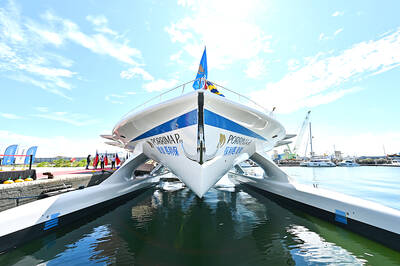Genndy Tartakovsky is a 35-year-old man who still wakes up early on Saturdays to watch cartoons. He confesses: "I can't outgrow them."
Even a night of hard drinking when he was younger wouldn't keep him from dragging himself out of bed the next morning to watch his favorite shows.
"I'd be so hung over," Tartakovsky said. ``But I loved them.''
That passion and persistence has paid off for Tartakovsky, whose list of credits includes hit animated television shows Samurai Jack and Star Wars: Clone Wars.
As creative director at Orphanage Animation Studios Inc, he now finds himself among a small group of northern California artists hoping to rival the towering frontrunners in Hollywood computer animation: Pixar Animation Studios Inc and Dreamworks Animation SKG Inc.
While the Bay Area upstarts have yet to make a feature-length film, firms such as Orphanage, Wild Brain Inc and CritterPix Inc have recently announced separate plans to make computer-animated feature films with characters they hope moviegoers will embrace as fondly as Pixar's Buzz Lightyear and Dreamworks' Shrek.
The rub is that the new players find themselves working on shoestring budgets, often with hand-me-down technology, and working under noose-tight deadlines.
"You can't look at Wild Brain in its current state and say we're going to be competitors to Pixar," said Charles Rivkin, who was named CEO of the San Francisco-based company in September. "On the other hand, we would hope in the near future we make it into their rearview mirror."
Pixar and Dreamworks, whose executives declined to comment for this story, benefit from technological prowess that cost them millions to develop. Their rendering software allows characters to interact in three dimensions, adding lifelike qualities that wow audiences.
Wild Brain and the Orphanage lack such resources, relying on off-the-shelf software and building other digital tools to enhance the quality, said BZ Petroff, Wild Brain's production director, who worked on Toy Story while at Pixar.
Wild Brain has the same improvisational spirit that Pixar had before anyone had coined the term computer animation, she said.
"Pixar had practically nobody who had worked on a motion picture before," Petroff recalled. "They had an industrial designer who worked on cars. Not Cars the Pixar movie but cars in Detroit. He worked in the automobile industry ... Nobody was doing this kind of work then."
When it comes to computer-generated short films, Wild Brain's system has proven successful.
In 2001, the company released Hubert's Brain, a dark comedy about a lonely boy who finds a talking brain. The 17-minute film won Best Professional Computer Generated Short Film at the 2001 World Animation Celebration in Los Angeles.
"The 3-D works, and it's a lot of fun," Karl Cohen, president of the Bay Area Animation Association, said of Hubert's Brain. "Whether they can turn that into a full-length feature is another question."
The Orphanage, founded in 1999 by three former employees of George Lucas' Industrial Light and Magic, is further behind Wild Brain in its evolution. The company is best known for supplying special effects for live-action films, such as The Day After Tomorrow and Sin City.
Hiring Tartakovsky, a golden boy at the Cartoon Network who will anchor the company's foray into features, has given Orphanage credibility within animation circles.
That these digital animation companies are cropping up in the Bay area is no accident. Civic leaders here are rolling out the red carpet for computer animation firms.
Computers, however, have done little to speed up the process or reduce the costs of making animated films. Pixar has produced only six films in 11 years and spent an average of US$77 million per movie, according to Bruce Nash, who runs The Numbers, an online movie information-data tracker.
Lacking those kind of resources, Wild Brain and Orphanage plan to leverage their expertise animating television shows, which require a faster turnaround, to produce films for about half as much money, executives from both companies said.
After spending 11 years producing mostly commercials, Wild Brain made its first significant strides toward the big screen when it penned a five-picture deal last year with Dimension Films, a unit of Walt Disney Co's Miramax Films.
Based on their agreement, each company will co-finance and co-produce films that Miramax will distribute.
Orphanage, headquartered in San Francisco, will seek a similar financing and distribution partnership once the company's story ideas are ready for production, Tartakovsky said.
Wild Brain plans to keep its costs down by contracting out the work to artists overseas, such as South Korea and China, to draw background and other scenes that can be easily mass-produced.
Some of the work for Wild Brain's Higglytown Heroes, a daily Disney Channel show, is done in South Korea, Rivkin said. Sending work overseas doesn't hurt the quality, he said.
Others aren't so sure.
Pixar and Dreamworks do all their work in-house.

GAINING STEAM: The scheme initially failed to gather much attention, with only 188 cards issued in its first year, but gained popularity amid the COVID-19 pandemic Applications for the Employment Gold Card have increased in the past few years, with the card having been issued to a total of 13,191 people from 101 countries since its introduction in 2018, the National Development Council (NDC) said yesterday. Those who have received the card have included celebrities, such as former NBA star Dwight Howard and Australian-South Korean cheerleader Dahye Lee, the NDC said. The four-in-one Employment Gold Card combines a work permit, resident visa, Alien Resident Certificate (ARC) and re-entry permit. It was first introduced in February 2018 through the Act Governing Recruitment and Employment of Foreign Professionals (外國專業人才延攬及雇用法),

WARNING: From Jan. 1 last year to the end of last month, 89 Taiwanese have gone missing or been detained in China, the MAC said, urging people to carefully consider travel to China Lax enforcement had made virtually moot regulations banning civil servants from making unauthorized visits to China, the Control Yuan said yesterday. Several agencies allowed personnel to travel to China after they submitted explanations for the trip written using artificial intelligence or provided no reason at all, the Control Yuan said in a statement, following an investigation headed by Control Yuan member Lin Wen-cheng (林文程). The probe identified 318 civil servants who traveled to China without permission in the past 10 years, but the true number could be close to 1,000, the Control Yuan said. The public employees investigated were not engaged in national

The zero emissions ship Porrima P111 was launched yesterday in Kaohsiung, showcasing the nation’s advancement in green technology, city Mayor Chen Chi-mai (陳其邁) said. The nation last year acquired the Swiss-owned vessel, formerly known as Turanor PlanetSolar, in a bid to boost Taiwan’s technology sector, as well as ecotourism in Palau, Chen said at the ship’s launch ceremony at Singda Harbor. Palauan President Surangel Whipps Jr and Minister of Foreign Affairs Lin Chia-lung (林佳龍) also attended the event. The original vessel was the first solar-powered ship to circumnavigate the globe in a voyage from 2010 to 2012. Taiwan-based Porrima Inc (保利馬) installed upgrades with

ENHANCE DETERRENCE: Taiwan has to display ‘fierce resolve’ to defend itself for China to understand that the costs of war outweigh potential gains, Koo said Taiwan’s armed forces must reach a high level of combat readiness by 2027 to effectively deter a potential Chinese invasion, Minister of National Defense Wellington Koo (顧立雄) said in an interview with the Chinese-language Liberty Times (sister newspaper of the Taipei Times) published yesterday. His comments came three days after US Secretary of State Marco Rubio told the US Senate that deterring a Chinese attack on Taiwan requires making a conflict “cost more than what it’s worth.” Rubio made the remarks in response to a question about US policy on Taiwan’s defense from Republican Senator John Cornyn, who said that Chinese